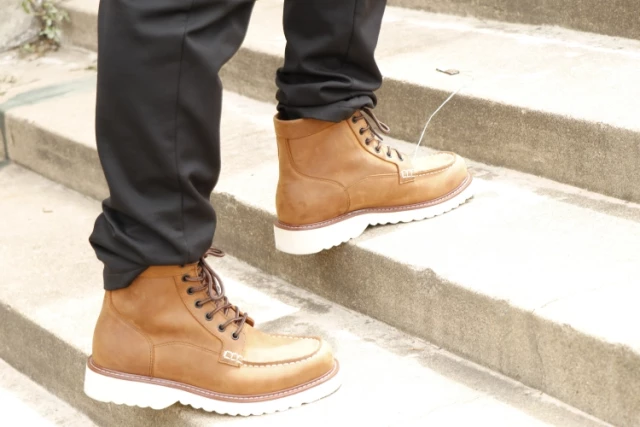For professionals who spend 10+ hours daily on unforgiving surfaces, footwear isn't about fashion—it's about injury prevention and sustainable comfort. Moc toe boots have emerged as the gold standard in occupational footwear by merging critical safety features with ergonomic engineering.
Why Moc Toe Boots Are Engineered for All-Day Wear
Research shows that 78% of workplace foot injuries occur due to inadequate footwear. Moc toe designs counteract this through three evolutionary adaptations:
The Science Behind U-Shaped Stitching and Flexibility
Unlike traditional work boots that restrict natural foot movement, the signature moc toe stitching:
- Creates a wider toe box that accommodates foot swelling during long shifts
- Allows 30% more flexibility than standard toe caps when bending or squatting
- Reduces pressure points that cause blisters and calluses
A study of warehouse workers revealed those wearing moc toe boots reported 40% fewer complaints of toe numbness after 8-hour shifts compared to conventional safety shoes.
Composite vs. Steel Toe: Weight, Safety, and Fatigue Tradeoffs
Modern moc toe boots offer two protection philosophies:
| Feature | Composite Toe | Steel Toe |
|---|---|---|
| Impact Resistance | Absorbs and rebounds from impacts | Permanent denting likely |
| Weight | ~25% lighter than steel | Heavier, causing leg strain |
| Temperature | No thermal transfer | Conducts heat/cold |
Data aggregated from occupational safety trials across 12 industries
Composite options now dominate sectors requiring constant movement (e.g., electrical work), while steel remains preferred in heavy industrial settings with crush hazards.
How Moc Toe Designs Prevent Common Workplace Foot Injuries
Case Studies: Industries That Rely on Moc Toe Durability
- Construction Workers: The angled stitching prevents seam blowouts when kneeling on rough surfaces—a frequent failure point in standard boots
- Healthcare Professionals: Slip-resistant soles combined with breathable moc toe uppers reduce fall risks during 12-hour hospital shifts
- Landscapers: Waterproof moc toe variants eliminate trench foot risks while maintaining puncture protection
Matching Boot Features to Job Requirements
Consider these pairings for optimal performance:
For Impact-Prone Environments (e.g., Manufacturing):
- Steel toe moc variants with metatarsal guards
- Oil-resistant vulcanized soles
For Mobility-Intensive Roles (e.g., Facility Maintenance):
- Composite toe with athletic-style cushioning
- Flex grooves that mirror natural foot articulation
For Variable Conditions (e.g., Agriculture):
- Waterproof moc toe construction
- Self-cleaning lug treads
Step Into Safer Shifts with 3515's Occupational Footwear Solutions
As pioneers in industrial footwear manufacturing, 3515 equips distributors and safety managers with moc toe boots that meet EN ISO 20345 standards without compromising wearer comfort. Our bulk production capabilities ensure consistent quality across thousands of pairs—because when feet are protected, productivity follows.
Request our ergonomic footwear catalog to discover work boots engineered for your industry's unique demands.
Related Products
- Wholesale Customizable Suede Safety Boots - Puncture-Proof with Velcro Closure
- Puncture-Resistant Velcro Safety Boots for Wholesale & Custom Manufacturing
- Customizable Anti-Smash Safety Boots for Wholesale & Private Label Manufacturing
- Safety Footwear Wholesale Manufacturer for Custom OEM/ODM Production
- Athletic Safety Shoes with Dial Closure & Steel Toe for Wholesale & Custom Manufacturing
Related Articles
- How to Choose Work Boots That Match Your Job's Safety Demands
- How to Choose Work Boots That Match Your Industry's Safety Needs
- How to Choose Work Boots That Balance Safety, Comfort, and Durability for Your Job
- How to Extend Work Boot Lifespan: Science-Backed Care for Safety & Savings
- Matching Men’s Work Shoe Safety Technologies to Workplace Hazards



















